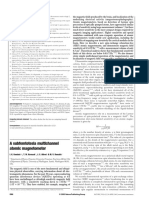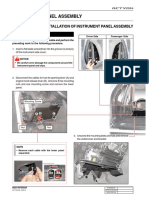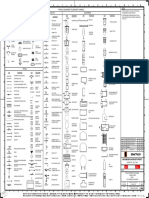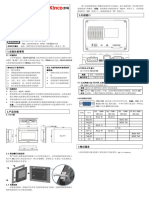Report On The Measurements of A New Material and New Type Magnetometer
Uploaded by
SteveAbonyiReport On The Measurements of A New Material and New Type Magnetometer
Uploaded by
SteveAbonyiReport on the Measurements of a New Material and New Type Magnetometer 1.
Introduction
Investigation has been made on the New Material and New Type Magnetometer constructed by Dipl. Ing. Istvn Abonyi. The New Material supposed to be a very high (room temperature) superconductor and as a sensor element of a New Type Magnetometer can provide a very high magnetic field sensitivity comparable to the !"I# based magnetometers. $reliminary measurements on the New Material have been carried out at %T&M'I (() #ebrecen) *ungary and in the #ept. of +eneral $hysics) ,-tv-s "niversity) .udapest) *ungary. The sensitivity measurement of the New Type Magnetometer was carried out in the #epartment for !"I# /onstruction at I$*T 0ena) +ermany (. They are e1uipped with the most recent measuring facilities li2e *ewlett $ac2ard pectrum %naly3er) and shielded room for high sensitive electric and magnetic measurement.
4. ,5perimental
4.1 The New Material The new material) fabricated in tape form) has been investigated by measuring the magnetic susceptibility (in %T&M'I) and electromagnetic wave absorption (at the #ept. of $hysics) from 66 ' to room temperature. The tape itself contains a very small amount of this New Material surrounded by very high permeability alloy. ,ven in the case of any measured peculiarities it made impossible to differentiate between magnetic and superconducting phase transition. This problem needs a more detailed investigation to get a definite determination of the properties of this new material and more developed method of fabrication of the New Material tape for containing much higher density of the New Material. It must be noted that the New Material as a sensing element can be very useful even if it were not superconducting. 4.4 The New Type Magnetometer The measurement of the sensitivity of the New Type Magnetometer was carried out in the #epartment for !"I# /onstruction. There was a shielded room and the measuring e1uipment was connected to the magnetometer by special shielded cable. The magnetic field for the measurement was generated by a coil which. was supplied by an %udio 7re1uency +enerator from outside the room. The sensor of the New Type Magnetometer was inside the coil.. ince the magnetic field of the coil is proportional to the current) the intensity of the magnetic field to be applied could be determined from the current provided by the %udio 7re1uency +enerator. The output of the magnetometer was connected to a *ewlett $ac2ard pectrum %naly3er. It was also outside the shielded room. %t first the sensitivity was tested in the field of 1 nT = 1000 pT in a wide audio fre1uency range as it can be seen in 7ig. 4.4.1 and 4.4.4. The measurements showed that the sensitivity of this first e5perimental e1uipment could be in the order of 188 pT in the audio fre1uency range. of 49 : 98 2*3) the sensitivity is limited by the noise) while in 7ig. 1.4.; and 1.4.< in a narrower fre1uency band li2e 1.9 2*3 and <88 *3 a few pT magnetic field can be well detected. The narrower the fre1uency band the less is the noise and due to the less noise the higher is the sensitivity.
3. /omparison the New Magnetometer with the !"I#s
uperconducting 1uantum interference devices ( !"I#s) use 0osephson effect phenomena to measure e5tremely small variations in magnetic flu5. !"I#s are operated as either R7 or dc !"I#s. *e prefi5es R7 or dc refers to whether the 0osephson =unction(s) is biased with an alternating current (R7 or a dc current. 7lu5 is normally inductively coupled into the !"I# loop via an input coil) which connects the !"I# to the e5periment. The !"I#s with the ade1uate cryostats and electronics are very e5pensive and they can operate only in a highly sophisticated infrastructure. There are several application of the !"I#s because of its high sensitivity to magnetic fields. It can be applied for measuring any other 1uantities which can be transformed to magnetic field. The most widespread applications of the !"I#s are showen in 7ig. 4.;.1. The possible biomagnetic use of the !"I#s together with magnetic field strength to be measured are displayed in 7ig. 4.;.4. The biomagnetic application seems to be possible in certain areas as it can be read from the figure where the different biomagnetic signal strength are displayed depending on the application field. The sensing element of the !"I#s can be made from either high:temperature superconductor (*T ) or low temperature superconductor (>T ). There are fundamental differences between *T and >T sensors. >T devices have significant advantages and one disadvantage ? operating temperature ? over *T devices. .ecause >T materials are isotropic it is possible to fabricate devices with three:dimensional structures. That allows crossover and multilayer structures that permit higher sensitivity than single turn devices. *T crossovers (needed for multilayer coils) re1uire larger dimensions. The effect is that an *T crossover acts as a 0osephson or insulating =unction with the addition of significant 1@f noise. The associated flu5 creep (particularly in *T ) by operating in the mi5ed state can lea to nonlinearity or hysteretic effects. The ma=or difference between the R7 and dc !"I#s is that the dc !"I# may offer 7ig. ;.1. 7ield sensitivities and bandwidths typical for various applications. The lines indicate the sensitivity of the commercially available !"I#s.
100 000
Cardiogram
Signal Strength [fT]
10 000
Oculogram Myogram Fetal Cardiogram Encephalogram (d) Encephalogram (a) Auditory Evoked Re pon e !i ual Evoked Re pn e
1 000
100
Retingram Evoked Cortical Activity
10
1 0,01
0,10
1,00
10,00
100,00
1000,00
Frequency [Hz]
7ig. ;.4. Typical signal strength and fre1uency ranges for various biomagnetic signals
7ig. ;.;. Typical design of a fiberglass dewar used for biomagnetic measurements. lower noise. The cost of the sensitivity can be the comple5ity of electronics needed to operate a dc !"I# and the difficulty in fabricating two nearly identical 0osephson =unctions in a single device. The detection coils because of the thermal shield can not be put directly onto the surface to be measured. The distance between the sample and detection coils (see Tail pacing in the picture) reduces the actual !"I# sensitivity. 7ig. 4.4.1 ignal:to:noise ratio in a 1888 pT %/ field in the 8:49 2*3 fre1uency range 7ig. 4.4.4. ignal:to:noise ratio in a 1888 pT %/ field in the 8:98 2*3 fre1uency range 7ig. 4.4.;. ignal:to:noise ratio in a 188 pT %/ field in the 8:1988 *3 fre1uency range 7ig. 4.4.<. ignal:to:noise ratio in a 18 pT %/ field in the <A88:9488 *3 fre1uency range
You might also like
- Daihatsu - 6 8DK-20 Spare Parts List (Heavy Fuel Oil) PDF100% (2)Daihatsu - 6 8DK-20 Spare Parts List (Heavy Fuel Oil) PDF366 pages
- A Sensitive Vibrating Sample MagnetometerNo ratings yetA Sensitive Vibrating Sample Magnetometer3 pages
- Harnessing The Power of Tiny Magnetic Field by Highly Sensitiv1No ratings yetHarnessing The Power of Tiny Magnetic Field by Highly Sensitiv116 pages
- High-SQUID Magnetometers For Biomagnetic MeasurementsNo ratings yetHigh-SQUID Magnetometers For Biomagnetic Measurements4 pages
- Squids: Compiled by Akshay - Mukund VII Sem E&CNo ratings yetSquids: Compiled by Akshay - Mukund VII Sem E&C38 pages
- A Spherical Coil Array For The Calibration of Whole-Head Magnetoencephalograph SystemsNo ratings yetA Spherical Coil Array For The Calibration of Whole-Head Magnetoencephalograph Systems10 pages
- Single-Beam Miniaturized Atomic Magnetometer With Square-Wave Modulation For MagnetoencephalographyNo ratings yetSingle-Beam Miniaturized Atomic Magnetometer With Square-Wave Modulation For Magnetoencephalography6 pages
- A Tunable RF SQUID Manipulated As Flux and Phase QubitNo ratings yetA Tunable RF SQUID Manipulated As Flux and Phase Qubit12 pages
- Atomicmagnetometer-Kominis Et Al. - A Subfemtotesla Multichannel Atomic MagnetometerNo ratings yetAtomicmagnetometer-Kominis Et Al. - A Subfemtotesla Multichannel Atomic Magnetometer4 pages
- Terfenol-D Based Magnetic Field Sensor With Temperature Independence Incorporating Dual Fiber Bragg Gratings StructureNo ratings yetTerfenol-D Based Magnetic Field Sensor With Temperature Independence Incorporating Dual Fiber Bragg Gratings Structure8 pages
- Analysis Design and Optimization of Compact UltraNo ratings yetAnalysis Design and Optimization of Compact Ultra13 pages
- A Perspective On Medical Applications of High Temperature SuperconductorsNo ratings yetA Perspective On Medical Applications of High Temperature Superconductors3 pages
- The Method of Instant Amplification of The MCG&MEG Signals: R. Sklyar Verchratskogo St. 15-1, Lviv 79010 UkraineNo ratings yetThe Method of Instant Amplification of The MCG&MEG Signals: R. Sklyar Verchratskogo St. 15-1, Lviv 79010 Ukraine4 pages
- Application Fields of High-Temperature SuperconductorsNo ratings yetApplication Fields of High-Temperature Superconductors14 pages
- Design, Simulation, Modeling, and Implementation of A Square Helmholtz Coil in Contrast With A Circular Coil For MRI ApplicationsNo ratings yetDesign, Simulation, Modeling, and Implementation of A Square Helmholtz Coil in Contrast With A Circular Coil For MRI Applications7 pages
- Instant Ebooks Textbook High Sensitivity Magnetometers 1st Edition Asaf Grosz Download All Chapters100% (11)Instant Ebooks Textbook High Sensitivity Magnetometers 1st Edition Asaf Grosz Download All Chapters62 pages
- A Numerical Treatment of The RF SQUID: II. Noise TemperatureNo ratings yetA Numerical Treatment of The RF SQUID: II. Noise Temperature57 pages
- Fluxgate Sensor With A Special Permalloy Core - Construction and InvestigationNo ratings yetFluxgate Sensor With A Special Permalloy Core - Construction and Investigation4 pages
- Spaced+Repetition+Spreadsheet+(Manthan+Patel)No ratings yetSpaced+Repetition+Spreadsheet+(Manthan+Patel)1 page
- International Journal of Aerospace Engineering - 2020 - Zheng - A Comprehensive Review of Atmosphere Breathing ElectricNo ratings yetInternational Journal of Aerospace Engineering - 2020 - Zheng - A Comprehensive Review of Atmosphere Breathing Electric21 pages
- Force On An Asymmetric Capacitor (Antigravity Ufo, Army Report Arl-Tr-3005)No ratings yetForce On An Asymmetric Capacitor (Antigravity Ufo, Army Report Arl-Tr-3005)38 pages
- Photovoltaic R&D in Germany: First-Class Research Partnerships Ensure A Sustainable EdgeNo ratings yetPhotovoltaic R&D in Germany: First-Class Research Partnerships Ensure A Sustainable Edge2 pages
- Explosions of Xenon Clusters in UltraintNo ratings yetExplosions of Xenon Clusters in Ultraint15 pages
- Waterpurifier: Mobile Drinking Water Treatment SystemNo ratings yetWaterpurifier: Mobile Drinking Water Treatment System4 pages
- Removal and Installation of Instrument Panel AssemblyNo ratings yetRemoval and Installation of Instrument Panel Assembly12 pages
- Indra: Piping & Equipment Flowsheet Symbols Speciality Items Valves EquipmentNo ratings yetIndra: Piping & Equipment Flowsheet Symbols Speciality Items Valves Equipment1 page
- 370 ZXM6-NHLD120 166 - 1755×1038 (30×20) - 350-370W - 350mm - ENo ratings yet370 ZXM6-NHLD120 166 - 1755×1038 (30×20) - 350-370W - 350mm - E2 pages
- Installation: Joystick For Inboard EVC-E3/E4 Twin: Typical Installation / Main Station100% (1)Installation: Joystick For Inboard EVC-E3/E4 Twin: Typical Installation / Main Station2 pages
- Powerpoint Presentation On Classification of TransducersNo ratings yetPowerpoint Presentation On Classification of Transducers18 pages
- MFL71100902 - 06 - S - 200630+smart TV Guide (WebOS 4.5) ENG+RS232 Guide ENGNo ratings yetMFL71100902 - 06 - S - 200630+smart TV Guide (WebOS 4.5) ENG+RS232 Guide ENG36 pages
- Twin Basket Launch and Recovery System (LARS) LARS-DB-3 PDFNo ratings yetTwin Basket Launch and Recovery System (LARS) LARS-DB-3 PDF6 pages
- Samsung Rf-263be Rf-263te Fast Track Troubleshooting100% (1)Samsung Rf-263be Rf-263te Fast Track Troubleshooting8 pages
- Solis_datasheet_S6-EH3P(8-15)K02-NV-YD-L_GlobalNo ratings yetSolis_datasheet_S6-EH3P(8-15)K02-NV-YD-L_Global2 pages












































































































